17 February 2006 A major photographic exhibition showing the artisans and farm workers who benefited from ORT projects in central and eastern Europe between the wars has opened in Paris to wide acclaim. The Tradesmen and Farmers of Yiddishland 1921-1938, features images held on original glass plates, hundreds of which were found in the cellar of the ORT France building by author and lawyer Serge Klarsfeld, who is one of the foremost historians on the fate of the Jews in France during the Holocaust. The images are part of the World ORT archive; some of them are due to appear this year on a specially designed website, and in an album with accompanying CD-ROM. They will appear alongside a wide range of previously unseen images and documents unearthed during ongoing research in the newly accessible archives of the former Soviet Union. The exhibition at the Musee dart et dhistoire du Judaisme (Museum of Jewish Art and History), is the result of a two-year labour of love by the head of ORT Frances Archives and History Department, Emmanuelle Polack. Ms Polacks research allowed the images to be properly captioned and enabled a multi-lingual (French, English and Yiddish) catalogue to be produced. The prestigious French newspaper Le Monde reported that the collection was a discovery for the world of photography. These portraits of farm workers and their families, scenes of life in the countryside, in schools and in factories, these photographs are works of art by the quality of the images, the force of their compositions, their monochromatic beauty. Ms Polack said she was surprised at first by the widespread and favourable attention the exhibition had received in the media. But these are very strong images that have a universal message, she said on reflection. Of course, we know that the people in the photographs are Jews but they could have been of any background. And we know that their lives were very hard and they suffered so much one immediately connects with these people and empathises with them. On the way to harvesting: a picture from the exhibition.. The pictures interweave the work of ORT with the history of the Jewish people. Professor Anne Grynberg, of Sorbonne University, writes in the exhibition catalogue how ORT was encouraging the emergence of a physically vigorous new Jew who would work the land or engage in the qualified trades for which he had been trained. Yet the images were taken as the Soviet Union was trying to attain a similar goal but through increasingly harsh methods and for very different reasons. The USSRs policies culminated in the forced collectivisation of the Jewish agricultural workers, the negation of their heritage and the disbanding of ORT in 1938. This is the first time that any of the 60 photographs have been on public view in France. However, in the late 1990s, before ORT had started to systematically organise the immense amount of archival material it had accumulated over the previous century, Mr Klarsfeld carried some of the photographs he had discovered in Paris to New York where a selection was exhibited at the Museum of Jewish Heritage under the title ORTworks Modernising Jewish Labour in the Early 20th Century. In his preface to the catalogue that accompanies the current Paris exhibition, Mr Klarsfeld, a Holocaust survivor and renowned Nazi hunter, referred back to comments he made at the opening of the New York show in highlighting the poignancy of the photographs. I emphasised the fact that ORT was and remains one of the strongest pillars of Jewish education in the world, he wrote. I stressed the link between these photos and the Shoah: many of these children and adults learning or working here, hunched over their books or tools or on the land, were killed a few years or decades later The Jewish masses and the individuals instructed by ORT, the people we see living and active in these photos, were carried away in their millions by the tempest of the Shoah. These photographs are an irreplaceable and deeply moving testimony to Jewish life before the Shoah. ORT projects in Central and Eastern Europe in 1923. The shaded area stretching from Lithuania in the north to the Crimea in the south is the Pale of Settlement, to which Jews were confined between 1835 and 1917. . ORT France National Director Marc Timsit said the exhibition had become a source of pride and satisfaction for the whole community as well as for ORT. This is a prestigious event which brings out the best qualities of our organisation, he said. The Tradesmen and Farmers of Yiddishland 1921-1938 runs until May 21. The Musee dart et dhistoire du Judaisme is at the Hotel de Saint-Aignan, 71 Rue du Temple, 75003 Paris. In Russia, World ORT is continuing to plough through previously restricted sources of material, from museums to government archives. The results of this research, which will form the basis of a new website, album and CD-ROM later in the year, include the discovery of a huge range of photographs and documents that shed light on the opportunities, illusions and tragedies that Jews and Jewish organisations faced under the Marxist regime between 1921 and 1939. Many of the documents weve discovered are in Yiddish, said Vladimir Dribinskiy, the Head of World ORTs Coordination Department. They include testimonies, reports, records of negotiations with the authorities and, most movingly, calls for help: we have found what may be the last things written by some of the ORT personnel who disappeared in Stalins Gulag. World ORT, founded in Russia in 1880, is the worlds largest Jewish education and vocational training non-government organisation with some 270,000 students Jewish and non-Jewish in 58 countries.

French applaud exhibition of ORT photographs
17.02.06




